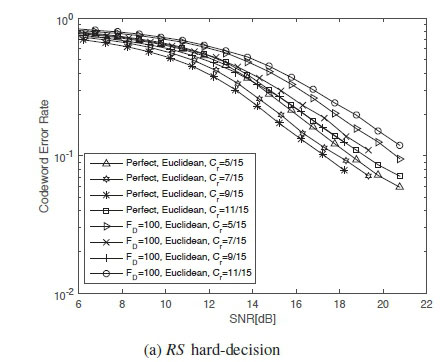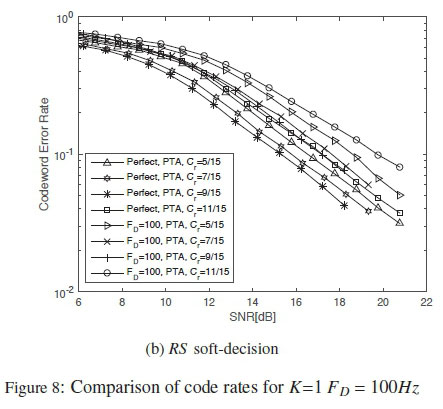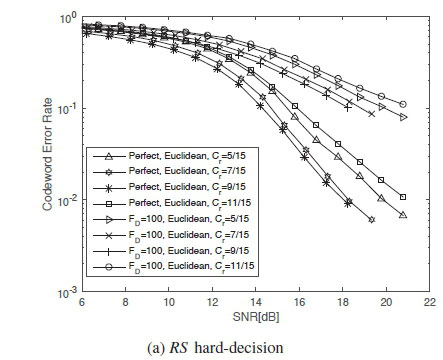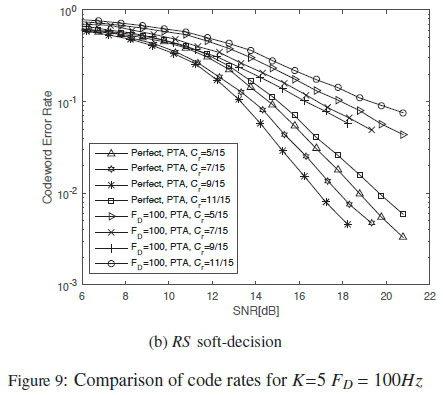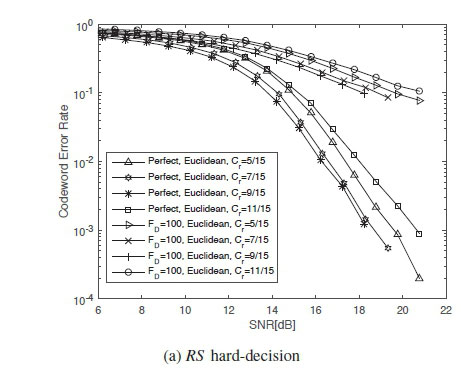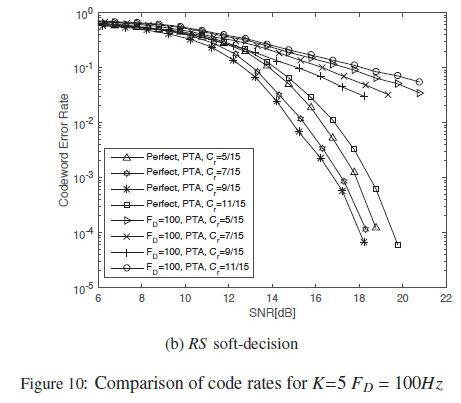Serviços Personalizados
Artigo
Indicadores
Links relacionados
-
 Citado por Google
Citado por Google -
 Similares em Google
Similares em Google
Compartilhar
SAIEE Africa Research Journal
versão On-line ISSN 1991-1696
versão impressa ISSN 0038-2221
SAIEE ARJ vol.108 no.3 Observatory, Johannesburg Set. 2017
On the analysis of Reed-Solomon codes for OFDM Systems over Rician fading channels
O.O. OgundileI, II; E. O. IjigaII; D.J.J. VersfeldIII
IDepartment of Physics and Telecommunication, Tai Solarin University of Education, Nigeria. E-mail: ogundileoo@tasued.ed.ng
IISchool of Electrical and Information Engineering,University of the Witwatersrand, Johannesburg, South Africa. E-mail:owoicho.ijiga1@students.wits.ac.za
IIISchool of Electrical and Information Engineering,University of the Witwatersrand, Johannesburg, South Africa. jaco.versfeld@wits.ac.za
ABSTRACT
The relative strength between the direct and the scattered paths of the received signal in wireless communication as described by the Rician factor K specifies the quality of the transmission link. Fading in Rician channel models influence the performance of Orthogonal Frequency Division Multiplexing (OFDM) systems. Accordingly, channel estimation together with different Forward Error Correction (FEC) schemes are used to provide significant performance gain for OFDM systems over fading channels. In most literature, the performance of FEC schemes such as Turbo and LDPC codes have been analysed for OFDM systems over frequency-selective Rician fading channels. This paper evaluates the performance of Reed-Solomon (RS ) codes over frequency-selective Rician fading channels. The performance of RS codes is firstly studied for different Rician K factors and Doppler frequencies. Secondly, the performance of RS codes is reviewed assuming different code rates (|) for both hard-decision and soft-decision decoding algorithms. The Euclidean algorithm (EA) is used as the RS hard-decision decoding algorithm while the Parity-check Transformation Algorithm (PTA) is deployed as the RS soft-decision decoding algorithm. The results for the various channel and coding conditions are documented through computer simulations. The simulation results validate the importance of a high Rician K factor. Interestingly, the simulation results verify that adopting a low-rate code do not necessarily improve the error rate irrespective of the Rician K factor. This analysis is relevant in order to establish the performance of combined RS codes with OFDM systems over frequency-selective Rician fading channels.
Key words: Code rates, Doppler frequency, OFDM system, RS codes, Rician channel, Rician K factor.
1. INTRODUCTION
Orthogonal Frequency Division Multiplexing (OFDM) is a transmission technique based on multi-orthogonal carriers which are simultaneously transmitted. OFDM is used for contemporary wireless communication systems and applications because it offers high data transmission rate, and efficient use of the limited spectrum resource. In addition, it is an effective technique to combat frequency-selective fading channels, as it is robust to Inter-symbol Interference (ISI) and Inter-carrier Interference (ICI) [1-3]. The motivation behind the use of OFDM is to cleave modulated signal (carriers) such as M-ary Quadrature Amplitude Modulation (M-QAM) into sizeable number of sub-carriers using the Inverse Discrete Fourier Transform (IDFT) [1,4]. In such a way, more information can be transmitted per bandwidth.
Nonetheless, in the studies of OFDM systems, potent channel estimation is essential due to the demodulation technique employed in OFDM systems, and the varying nature of the fading channels. Coherent demodulation for OFDM systems require reliable channel estimation techniques, most especially at high Doppler frequencies and for time-varying fading channels [1, 5]. In order to achieve coherent demodulation in Line of Sight (LOS) wireless communication channels usually modelled with a Rician distribution, the channel properties are firstly estimated. Different channel estimation techniques have been proposed in literature for OFDM systems over Rician fading channels. For instances, see [1,6-9]. The major emphasis have been to improve the quality of the received signal, most especially when the power in the scattered paths is more than the power in the direct paths (Rician K factor < 1). The ratio of the power in the direct paths and other scattered paths (referred to as the Rician K factor) serves as the scaling factor in Rician distributed channels. It is desired that K is as high as possible in order to achieve coherent demodulation. However, due to the variation in the channel's properties, the value of K is presumptive. Thus, it is paramount to estimate the fading effect in Rician channels so as to improve the probability of detecting the message that was transmitted correctly.
Despite these reliable channel estimation techniques proposed in literature, Forward Error Correction (FEC) schemes such Turbo codes and Low Density Parity Check (LDPC) codes are combined with these channel estimation techniques to improve the performance of OFDM systems over frequency-selective Rician fading channels. In [10-14] the performance of Turbo codes and Low Density Parity Check (LDPC) codes were validated for Rician fading channels. In this paper, the performance of Reed-Solomon (RS ) codes over frequency-selective Rician fading channels is analysed assuming OFDM systems. Firstly, we studied the performance of RS codes for different Rician K factors and Doppler frequencies FD. Afterwards, the performance of RS codes is reviewed assuming different code rates  for both hard-decision and soft-decision decoding algorithms, where n is the codeword length and k is the information symbol length.
for both hard-decision and soft-decision decoding algorithms, where n is the codeword length and k is the information symbol length.
RS codes form a prime class of linear block codes efficient in correcting random symbol errors and burst errors [15-17]. RS codes are very popular linear block codes because they meet the singleton bounds; as such, they are referred to as Maximum Separable Distance (MSD) codes [18]. Accordingly, a (n, k) RS code is capable of correcting up to |_(n - k)/2J errors when hard-decision decoding algorithm is deployed. Reliable hard-decision decoding algorithms for RS codes in literature include [19-22]. On the other hand, RS soft-decision decoding algorithms such as [18,23-27] can correct beyond the MSD error bound. However, this paper adopts the Euclidean algorithm (EA) [17, 21] as the RS hard-decision decoding algorithm while the Parity-check Transformation Algorithm (PTA) [18] is deployed as the RS soft-decision decoding algorithm.
Besides, in the OFDM-RS experimental set-up, we adopted M-QAM (M=16) as the underlying modulation scheme. To ally the 16-QAM modulation symbols with the RS symbols, the size of the RS symbols is selected to be 4 bits. Therefore, the RS codes of heed have a n=15. In pursuance of varying the code rate Cr, k is adjusted between k = 5 - 11. The channel estimation technique used in this paper is based on the Pilot Symbol Assisted Modulation (PSAM) Least Square (LS) method [1, 3]. Moreover, we assume the comb-type pilot arrangement for the channel estimation [1,3]. The pilot symbol spacing of the LS estimator and the channel's Doppler frequency FDare varied in order to give concrete remarks. The results for the various channel and coding conditions are documented through computer simulations as shown in Fig 4-Fig 10.






The importance and contribution of this paper is as follows. The Rician channel used in this paper supports both urban and commercial wireless communications. With RS codes being an important class of FEC schemes, it is therefore paramount to validate the performance of RS codes in such a channel as in the case with other FEC schemes. In addition, the performance of RS codes is evaluated with OFDM systems over this channel. OFDM-RS systems are used in different wireless communication applications such as Digital Video Broadcasting (DVB), Digital Audio Broadcasting (DAB), WiMAX, Digital Subscriber Line (DSL), Long Term Evolution (LTE), and long distance satellite communications [28]. Consequently, this paper is relevant in asserting the performance of OFDM-RS over frequency-selective Rician fading channels when these wireless applications are deployed.
The rest of this paper is arranged as follows. Section 2 describes the OFDM-RS system model. Specifically, this section explains the RS coding process, the OFDM transmission technique, the channel model, and the channel estimation technique adopted in this paper. The performance of the OFDM-RS system in frequency-selective Rician fading channel is presented with analysis in Section 3. In particular, this section analyses the performance for different Rician K factor, Doppler frequencies FD, and code rate Cr. Section 4 summarises the findings of this paper with discernible remarks.
2. OFDM-RS SYSTEM MODEL
Consider the OFDM-RS system experimental set-up of Fig. 1. The input to the system is encoded using a (n, k) RS code. The encoded data of length n is mapped to 16-QAM complex symbols. Pilot symbols are inserted in the mapped data periodically assuming comb-type pilot based arrangement as shown in Fig. 2 [3]. Afterwards, we apply the default OFDM transmission procedure which includes the Serial-to-Parallel (S /P) conversion, IDFT, Parallel-to-Serial (P/S ) conversion, cyclic prefix insertion, and Digital-to-Analogue conversion (DAC). The reverse of these steps are performed after the channel. Subsequently, the pilot symbols are removed in order to estimate/compensate for the channel fading effect. The compensated received signal is hereby fed into the RS decoder which outputs the decoded message. The OFDM-RS system model is therefore expatiated as follows.
2.1 Reed-Solomon Encoding
The input message can be encoded to form a systematic codeword or non-systematic codeword. For the purpose of this paper and easy adaptation of the RS PTA soft decoder [18], we will simply use systematic RS encoder. In the systematic form, the message polynomial M(x) is embedded in the codeword C(x) as depicted in Fig. 3. Thus, we encoded the input message k as follows. Let the k input message be represented by a message polynomial of degree k - 1 as:
of degree k - 1 as:

where the coefficients  are m (m = 4) bits message symbol which indicates an element of the GF(qm). The message polynomial is hereby scaled by a factor x(n-k)such that:
are m (m = 4) bits message symbol which indicates an element of the GF(qm). The message polynomial is hereby scaled by a factor x(n-k)such that:

The resulting message  is divided by the field generator polynomial
is divided by the field generator polynomial  which gives a quotient Q(x) and remainder R(x) defined as:
which gives a quotient Q(x) and remainder R(x) defined as:

In this case, we define the  with symbols from GF(q) and with roots α, α2,αn-kas [17]:
with symbols from GF(q) and with roots α, α2,αn-kas [17]:

where α is the primitive element in GF(q). In its extended form, the k x n generator matrix G of the RS code is defined as:
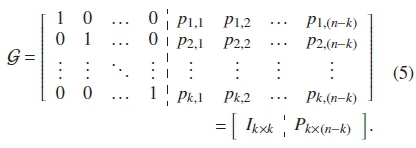
In order to perform the RS EA and PTA decoding, the parity check matrix H needs to be predefined. Thus, for the (n, k) RS code the H is defined as:
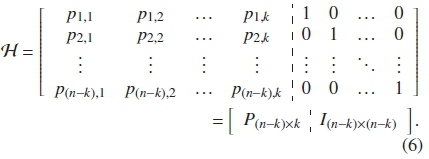
The systematic RS codeword is therefore formed by fusing the message polynomial M(x), the scaling factor x(n-k) and the remainder R(x) as given by:

From Eqn. 7, the generated codeword contains the message symbols and the parity symbols as shown in Fig. 3.
With the RS encoder in place, the RS decoder can be set up to achieve either hard-decision or soft-decision decoding. The EA [17, 21] is adopted for the RS hard-decision decoding, and the PTA proposed in [18] is assumed for the soft-decision decoding. The EA [17,21] has been proven to perform at par with the conventional RS hard-decision decoding algorithm proposed in [19, 20]; thus, the EA [17,21] is capable of correcting up to |_(n - k)/2J errors. The EA performs RS decoding by iteratively finding the error location polynomial and error location evaluator from the computed syndrome. Consequently, the algorithm evaluates the error location numbers and values in order to correct the errors.
On the other hand, the PTA [18] is a soft-decision RS decoding algorithm that corrects beyond the [(n - k)/2] error bound depending on the derived reliability information from the channel output. As with most soft-decision FEC schemes, the performance of the PTA depends strongly on the derived reliability information.
The PTA is a symbol level RS soft decoder that transforms the parity-check matrix H iteratively so as to perform a syndrome check [18]. With every iteration, the PTA fine-tunes the derived reliability information according to some rules. Note that the derived reliability information is of dimension M χ n, where M and n are defined as above. For an efficient and less computational intensive way of deriving the reliability information from the channel output, refer to [29, 30]. The decoding performance of the PTA depends on the correction factor δ chosen in the algorithm. The smaller the value of δ, the more efficient is the decoder. However, reducing the value of δ will increase the decoding time complexity of the PTA. A correction factor δ = 10-3 is assumed in this paper in order to achieve a good Symbol Error Rate (SER) performance at moderate decoding time complexity.
2.2 OFDM Transceiver
The (n, k) RS codeword is mapped to a 16-QAM complex data. Thus, the OFDM modulator is designed as follows. The number of sub-carriers (O) is set to O = 2L. The sub-carriers are numbered as i = 1,2,...,0 - 1, and the OFDM symbols are assigned u = 1,2,...,U - 1. Pilot symbols p are inserted periodically in the OFDM symbol assuming comb-type pilot arrangement. We assume all pilot symbol takes on the same value and equal spacing in order to lessen the channel estimation error [31]. Note that L is the ratio of the total number of data sub-carriers (J) to the number of pilot sub-carriers (Op). Subsequently, the OFDM frame structure is first fed into the S /P conversion block. The OFDM frequency domain signal is transformed into time domain in the IDFT block as [2, 3]:

where ρ is the DFT length and s(T) is the OFDM frequency domain signal. In most cases, the carrier is padded with zeros so that it matches the length of the filter size during the transformation process. The resulting time domain signal is fed into the P/S conversion block. Cylic prefix is added to the time domain OFDM signal in order to limit the effect of ISI. The time domain signal is up-converted in the DAC block before transmitted over the frequency-selective Rician fading channel.
At the receiver end, the time domain OFDM signal is first down-converted in the ADC block, The cyclic prefix is removed before passing the signal into the S /P conversion block. Thus, the time domain OFDM signal is transformed back to the frequency domain as [2, 3]:

where y(E) is the received time domain OFDM signal.
Given that the ISI is eliminated by the cyclic prefix, the received signal at the P/S conversion block is defined as:

where X(l) is the transmitted data and pilot frame, N(l) is the complex Additive White Gaussian Noise (AWGN) with variance σ2 = No/2, and H(l) is the combined frequency response. The matrix of the DFT is the defined

as [2,3]: with a weight of [2, 3]:

The Channel State Information (CSI) is known only at the pilot positions in reality. Accordingly, the CSI at the data symbol position is estimated using the known properties of the pilot symbols. Different approaches can be used to estimate the CSI at the data positions. For a low computational complexity, we estimate the CSI at the data symbol positions using the comb-type pilot based LS channel estimation method [1, 3].
2.3 LS Channel estimator
In its simplest form, the pilot symbols are inserted periodically in the modulated data signal X(i) in comb-type pilot based arrangement as defined by [3]:

where Xp(a) is the ath pilot carrier value. Therefore, the frequency response at the pilot sub-carrier using the LS channel estimation method is defined as [3]:

where X(p) and R(p) are the transmitted and received pilot sub-carriers respectively. Having derived the frequency response at the pilot sub-carrier, we apply linear interpolation [3, 32] to estimate the frequency response at the data sub-carrier. Accordingly, the frequency response at the data sub-carrier i, aL < i < (a + 1)L, is estimated as [3,32]:

2.4 Channel Model
The zero mean complex Gaussian Rician fading channel model assumed in this paper is developed by including a LOS path to a Rayleigh distributed channel. The complex Gaussian process is simulated as described by the Sum of Sinusoids (SOS) model in [33] which statistical properties match the Clarke isotropic scattering model [34]. We modeled the LOS path as a zero mean stochastic sinusoids as proposed in [35]. Therefore, the simulated Rician fading channel model assumed in this paper is expressed as [33,36]:

where Wreand Wimare the real and imaginary parts respectively, and are they are expressed as:
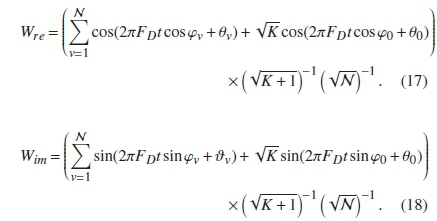
The number of propagation paths is denoted as N, and ψ ν is the angle of arrival of the vth propagation path defined as [36,37]:

Note that when φ ν = 0, FDis the maximum Doppler frequency, and t is the time of arrival of the vth propagation path. The angles Θ, ϋ ν , and θ ν are distributed invariably over [-π, π], and are statistically independent [36]. Moreover, θ0 is the preparatory random phase distributed invariably over [-π,π], and φ0 is the preparatory angle of arrival. From Eqns. (17) and (18), if the Rician K factor tends toward zero (K = 0), it implies that there are no LOS components; as such, Eqn. (16) can be regarded as a Rayleigh fading channel model.
3. PERFORMANCE ANALYSIS
This section presents the computer simulations run in MATLAB. The feasibility of the system is analysed by comparing the SER performance over a specified range of Signal to Noise Ratio (SNR). The SER versus SNR performance is compared for different code rates Cr, Rician K factors, Doppler frequencies FDand pilot spacings based on the parameters in Table 1. In the OFDM-RS system configuration, perfect synchronisation is assumed in order to limit the effect of ICI and ISI. The cyclic prefix is selected such that it is more than the maximum average path gain. Additionally, it is ensured in the simulation set-up that the first of the four taps used always have a zero path delay which approximately corresponds to an ideal synchronisation.

The key goal of this paper is to analyse the performance of RS codes for OFDM systems in frequency-selective Rician fading channels. Therefore, this section is structured as follows. The performance of RS codes is first studied for different Rician K factors, Doppler frequencies FD, and pilot spacings in Section 3.1 while assuming a fixed code rate Cr. Thereafter, the OFDM-RS system is compared for a range of code rates Crin Section 3.2 in order to verify the effect of Cron the system performance.
3.1 SER Analysis for Different K, FD, and Pilot Spacing
Rician K Factors: The performance of RS codes is investigated for different Rician K factors as shown in Fig. 4 and Fig. 5. A perfect channel condition is assumed in the simulation set-up for a fixed Doppler frequency (FD = 100Hz), while we vary the Rician K factor. A code rate, and
and are used in the simulation results of Fig. 4 and Fig. 5 respectively. As depicted in both figures (Fig. 4 and Fig. 5), the performance of the OFDM-RS system degrades as the Rician K factor reduce irrespective of the code rate. This establishes the importance of the Rician K factor in a Rician fading channel: the lower the Rician K factor, the harsher is the Rician channel fading effect irrespective of the OFDM-RS system configuration. Moreover, as expected, the PTA outperforms the hard-decision Euclidean algorithm irrespective of the value of K.
are used in the simulation results of Fig. 4 and Fig. 5 respectively. As depicted in both figures (Fig. 4 and Fig. 5), the performance of the OFDM-RS system degrades as the Rician K factor reduce irrespective of the code rate. This establishes the importance of the Rician K factor in a Rician fading channel: the lower the Rician K factor, the harsher is the Rician channel fading effect irrespective of the OFDM-RS system configuration. Moreover, as expected, the PTA outperforms the hard-decision Euclidean algorithm irrespective of the value of K.
Doppler Frequencies FD: In this case, the performance of the RS codes is verified for different Doppler frequencies FD. As shown in Fig. 4 and Fig. 5, a higher Rician K factor improves the performance of the OFDM-RS system. Thus, we select K=10 in the simulation runs, and a fixed code rate,  . Moreover, a pilot spacing of 4 is assumed in the LS channel estimation. Fig. 6 verifies the performance of the OFDM-RS system on frequency-selective Rician fading channel. Fig. 6 compares the performance of the OFDM-RS system for perfect channel condition (no pilot symbols), and with known pilot symbols. As shown in Fig. 6, the performance of the OFDM-RS system plummets as the Doppler frequency increases in comparison to the perfect channel condition. With fading channels, the higher the Doppler frequency the faster the channel fading effect. Therefore, it is difficult to track or estimate the channel fading effect in a fast fading channel. This is the reason why the performance of the OFDM-RS system drops as the Doppler frequency increases. In addition, irrespective of the value of Doppler frequency, the PTA outperforms the hard-decision Euclidean algorithm as shown in Fig. 6.
. Moreover, a pilot spacing of 4 is assumed in the LS channel estimation. Fig. 6 verifies the performance of the OFDM-RS system on frequency-selective Rician fading channel. Fig. 6 compares the performance of the OFDM-RS system for perfect channel condition (no pilot symbols), and with known pilot symbols. As shown in Fig. 6, the performance of the OFDM-RS system plummets as the Doppler frequency increases in comparison to the perfect channel condition. With fading channels, the higher the Doppler frequency the faster the channel fading effect. Therefore, it is difficult to track or estimate the channel fading effect in a fast fading channel. This is the reason why the performance of the OFDM-RS system drops as the Doppler frequency increases. In addition, irrespective of the value of Doppler frequency, the PTA outperforms the hard-decision Euclidean algorithm as shown in Fig. 6.
Pilot Spacings: The performance of the OFDM-RS system is also verified for different pilot spacings. In the simulation runs, we assumed two different pilot spacings (4 and 6), a fixed code rate,  , and a Doppler frequency, FD = 100Hz. Similarly, a Rician factor, K = 10 is selected in the simulation set-up. Fig. 7 shows the SER versus SNR performance of the OFDM-RS system for the varied pilot spacing. The figure compares the SER performance of the two pilot spacings with a perfect channel condition. As represented in the figure, the performance of the OFDM-RS system degrades as the pilot spacing increases from 4 to 6. Thus, the channel estimation process can be improved by using a smaller pilot spacing. This however increases the bandwidth and energy consumption, and reduces the data transmission rate. Most channel estimation techniques are more efficient with smaller pilot spacings because with large pilot spacing, the channel fading effect becomes complex and difficult to estimate. This results in the performance degradation in the OFDM-RS system as the pilot spacing increases. Likewise, as shown in Fig. 7, the soft-decision PTA offers better performance in comparison to the hard-decision Euclidean algorithm for any given pilot spacing.
, and a Doppler frequency, FD = 100Hz. Similarly, a Rician factor, K = 10 is selected in the simulation set-up. Fig. 7 shows the SER versus SNR performance of the OFDM-RS system for the varied pilot spacing. The figure compares the SER performance of the two pilot spacings with a perfect channel condition. As represented in the figure, the performance of the OFDM-RS system degrades as the pilot spacing increases from 4 to 6. Thus, the channel estimation process can be improved by using a smaller pilot spacing. This however increases the bandwidth and energy consumption, and reduces the data transmission rate. Most channel estimation techniques are more efficient with smaller pilot spacings because with large pilot spacing, the channel fading effect becomes complex and difficult to estimate. This results in the performance degradation in the OFDM-RS system as the pilot spacing increases. Likewise, as shown in Fig. 7, the soft-decision PTA offers better performance in comparison to the hard-decision Euclidean algorithm for any given pilot spacing.
3.2 Optimal Code Rate
The effect of the Rician K factor on the RS code rate, Cris verified in this section. In the simulation runs, we selected four different codes rates, and a fixed Doppler frequency, FD = 100Hz. Besides, a pilot spacing of 4 is assumed in LS channel estimation. Fig. 8, Fig. 9, and Fig. 10 verify the code rate performance comparison for the OFDM-RS system with Rician factors K=1, K=5 and K =10 respectively. The figures compare the code rate performance for a perfect channel condition, and with known pilot symbols. Fig. 8a, Fig. 9a, and Fig. 10a establish the performance of the OFDM-RS system for hard-decision decoding while Fig. 8b, Fig. 9b, and Fig. 10b depict the performance of the system for soft-decision decoding. With emphasis to Section 3.1, and as shown in Fig. 8, Fig. 9, and Fig. 10, the value of the Rician K factor has significant effect on the rate performance of the system. However, from the figures, it can seen that decreasing the code rate do not necessarily improve the performance of the OFDM-RS system over the channel even at high Rician K factor. In fact,
and a fixed Doppler frequency, FD = 100Hz. Besides, a pilot spacing of 4 is assumed in LS channel estimation. Fig. 8, Fig. 9, and Fig. 10 verify the code rate performance comparison for the OFDM-RS system with Rician factors K=1, K=5 and K =10 respectively. The figures compare the code rate performance for a perfect channel condition, and with known pilot symbols. Fig. 8a, Fig. 9a, and Fig. 10a establish the performance of the OFDM-RS system for hard-decision decoding while Fig. 8b, Fig. 9b, and Fig. 10b depict the performance of the system for soft-decision decoding. With emphasis to Section 3.1, and as shown in Fig. 8, Fig. 9, and Fig. 10, the value of the Rician K factor has significant effect on the rate performance of the system. However, from the figures, it can seen that decreasing the code rate do not necessarily improve the performance of the OFDM-RS system over the channel even at high Rician K factor. In fact,  gives the best performance both for the hard-decision and soft-decision RS decoding algorithms, and for K =1-10.
gives the best performance both for the hard-decision and soft-decision RS decoding algorithms, and for K =1-10.
From the studies of FEC, it is well known that low-rate codes are proficient in correcting more errors as compared to high-rate codes. Although, this comes with the price of reduced energy per codeword symbol. The reduced energy per codeword symbol means there are more errors to be corrected and this reduce the error correction performance. Therefore, there is a point at which decreasing the code rate will not offer any more performance improvements in error rate [38]. This is why the  system gives the best performance as shown in Fig. 8, Fig. 9, and Fig. 10. Consequently, when comparing the performance of different code rate, it is paramount to maintain the total energy transmitted per symbol message constant. This will ensure a fair comparison between the different code rate systems as presented in this section.
system gives the best performance as shown in Fig. 8, Fig. 9, and Fig. 10. Consequently, when comparing the performance of different code rate, it is paramount to maintain the total energy transmitted per symbol message constant. This will ensure a fair comparison between the different code rate systems as presented in this section.
4. CONCLUSION
This paper has studied the performance of OFDM-RS systems on frequency-selective Rician fading channels. From the simulation runs generated, the following conclusion can be deduced. Firstly, RS codes is a suitable FEC scheme and can be used with OFDM systems on frequency-selective Rician fading channels. Secondly, as with any other FEC scheme, the performance of RS codes can be improved on Rician fading channels by increasing the Rician K factor as presented in Section 3.1. Finally, as presented in Section 3.2, adopting a low-rate code in the OFDM-RS system do not necessarily improve the error rate as compared to high-rate code even at high Rician K factor. Note that a codeword length «=15 is adopted in this paper. However, the result in this paper can be extended to longer codeword length, where a higher QAM signal constellation (M) can be used.
REFERENCES
[1] A. Mousa and H. Mahmoud, "Channels estimation in OFDM system over rician fading channel based on comb-type pilots arrangement," IET Signal Processing, vol. 4, no. 5, pp. 598-602, Oct 2010. [ Links ]
[2] O. Ogundile and D. Versfeld, "Performance evaluation of polynomial based channel estimation for OFDM systems on time-varying frequency-selective fading channels," in AFRICON, 2015, Sept 2015, pp. 1-6.
[3] S. Coleri, M. Ergen, A. Puri, and A. Bahai, "Channel estimation techniques based on pilot arrangement in OFDM systems," Broadcasting, IEEE Transactions on, vol. 48, no. 3, pp. 223-229, Sep 2002. [ Links ]
[4] L. Rugini, P. Banelli, and G. Leus, "Simple equalization of time-varying channels for OFDM," IEEE Communications Letters, vol. 9, no. 7, pp. 619-621, July 2005. [ Links ]
[5] O. O. Oyerinde and S. H. Mneney, "Decision Directed Channel Estimation for OFDM Systems Employing Fast Data Projection Method Algorithm," in 2009 IEEE International Conference on Communications, June 2009, pp. 1-5.
[6] M. M. Jabbari and H. Nooralizadeh, "Advantages of MEMO channel estimation in Rician flat fading environments," in Electronic Devices, Systems and Applications (ICEDSA), 2011 International Conference on, Kuala Lumpur,, 2011, pp. 11-16.
[7] Y. Ma, R. Schober, and D. Zhang, "Exact BER for M-QAM with MRC and Imperfect Channel Estimation in Rician Fading Channels," IEEE Transactions on Wireless Communications, vol. 6, no. 3, pp. 926-936, March 2007. [ Links ]
[8] W. Gappmair and M. Bergmann, "Estimation of carrier and channel parameters in time-selective fading channels," IET Communications, vol. 9, no. 12, pp. 1474-1478, 2015. [ Links ]
[9] A. Pirsiavash and M. J. Emadi, "Rician channel characterization in OFDM systems," in 2015 23rd Iranian Conference on Electrical Engineering, May 2015, pp. 303-307.
[10] M. Kovaci and H. Balta, "Turbo codes performance on Rice flat fading environment," in Electronics and Telecommunications (ISETC), 2014 11th International Symposium on, Nov 2014, pp. 1-4.
[11] M. Kovaci, H. Balta, and M. Nafornita, "On using turbo codes over Rice flat fading channels," in Signals, Circuits and Systems, 2009. ISSCS 2009. International Symposium on, July 2009, pp. 1-4.
[12] A. Radosevic, T. M. Duman, J. G. Proakis, and M. Stojanovic, "Selective decision directed channel estimation for OFDM communications over multipath Rician fading channels," in 2012 IEEE 13th International Workshop on Signal Processing Advances in Wireless Communications (SPAWC), June 2012, pp. 555-559.
[13] D. M. Gruenbacher and A. Serener, "Performance of coded OFDM in a fading environment using high rate low-density parity-check codes," in Global Telecommunications Conference, 2001. GLOBECOM '01. IEEE, vol. 1, 2001, pp. 504-508 vol.1.
[14] S. A. Ghauri, M. E. U. Haq, M. Iqbal, and J. U. Rehman, "Performance Analysis of LDPC Codes on Different Channels," in 2014 Eighth International Conference on Next Generation Mobile Apps, Services and Technologies, Sept 2014, pp. 235-240.
[15] I. G. Reed and G. Solomon, "Polynomial codes over certain finite fields," J. Soc.Ind. Appl. Maths., pp. 8:300-304, June 1960.
[16] T. K. Moon, Error Correction Coding: Mathematical Methods and Algorithms. John Wiley & Sons, July 2005.
[17] S. Lin and D. J. Costello, Error Control Coding, 2nd ed. Prentice Hall, June 2005.
[18] O. Ogundile, Y. Genga, and D. Versfeld, "Symbol level iterative soft decision decoder for Reed-Solomon codes based on parity-check equations," Electronics Letters, vol. 51, no. 17, pp. 1332-1333, 2015. [ Links ]
[19] E. R. Berlekamp, Algebraic Coding Theory. New York: McGraw-Hill, Inc., 1968. [ Links ]
[20] J. Massey, "Shift-register synthesis and bch decoding," Information Theory, IEEE Transactions on, vol. 15, no. 1, pp. 122-127, Jan 1969. [ Links ]
[21] Y. Sugiyama, M. Kasahara, S. Hirasawa, and T. Namekawa, "A method for solving key equation for decoding goppa codes," Information andControl, vol. 27, no. 1, pp. 87 - 99, 1975. [ Links ]
[22] L. R. Welch and E. R. Berlekamp, "Error correction for algebraic block codes," Patent US 4 633 470, Dec 30, 1986.
[23] R. Koetter and A. Vardy, "Algebraic soft-decision decoding of Reed-Solomon codes," Information Theory, IEEE Transactions on, vol. 49, no. 11, pp. 2809-2825, Nov 2003. [ Links ]
[24] V. Guruswami and M. Sudan, "Improved decoding of Reed-Solomon and algebraic-geometric codes," in Foundations of Computer Science, 1998. Proceedings. 39th Annual Symposium on, Nov 1998, pp. 28-37.
[25] O. Ur-rehman and N. Zivic, "Soft decision iterative error and erasure decoder for Reed-Solomon codes," Communications, IET, vol. 8, no. 16, pp. 2863-2870, 2014. [ Links ]
[26] J. Jiang and K. Narayanan, "Iterative Soft-Input Soft-Output Decoding of Reed-Solomon Codes by Adapting the Parity-Check Matrix," Information Theory, IEEE Transactions on, vol. 52, no. 8, pp. 3746-3756, Aug 2006. [ Links ]
[27] M. Albanese and A. Spalvieri, "Two algorithms for soft-decision decoding of Reed-Solomon codes, with application to multilevel coded modulations," Communications, IEEE Transactions on, vol. 56, no. 10, pp. 1569-1574, October 2008. [ Links ]
[28] O. Ogundile, O. Oyerinde, and D. Versfeld, "Decision directed iterative channel estimation and Reed-Solomon decoding over flat fading channels," IET Communications, vol. 9, no. 17, pp. 2077-2084, 2015. [ Links ]
[29] O. Ogundile and D. Versfeld, "Improved reliability information for rectangular 16-QAM over flat rayleigh fading channels," in Computational Science and Engineering (CSE), 2014 IEEE 17th International Conference on, Dec 2014, pp. 345-349.
[30] _______, "Improved reliability information for OFDM systems on time-varying frequency-selective fading channels," in Wireless Telecommunications Symposium (WTS), 2015, April 2015, pp. 1-7.
[31] I. Barhumi, G. Leus, and M. Moonen, "Optimal training design for MIMO OFDM systems in mobile wireless channels," IEEE Transactions on Signal Processing, vol. 51, no. 6, pp. 1615-1624, June 2003. [ Links ]
[32] L. Cimini, "Analysis and Simulation of a Digital Mobile Channel Using Orthogonal Frequency Division Multiplexing," IEEE Transactions on Communications, vol. 33, no. 7, pp. 665-675, Jul 1985. [ Links ]
[33] Y. R. Zheng and C. Xiao, "Improved models for the generation of multiple uncorrelated Rayleigh fading waveforms," IEEE Communications Letters, vol. 6, no. 6, pp. 256-258, June 2002. [ Links ]
[34] R. H. .Clarke, "A statistical theory of mobile-radio reception," Bell System Technical Journal, pp. 975-1000, Jul-Aug 1968.
[35] C. Xiao and Y. R. Zheng, "A statistical simulation model for mobile radio fading channels," in Wireless Communications and Networking, 2003. WCNC 2003. 2003 IEEE, vol. 1, March 2003, pp. 144-149 vol.1.
[36] A. Trivedi and R. Gupta, "On the Analysis of Envelope Correlation and Spectra for Rician Fading Channel," Wireless Personal Communications, vol. 47, no. 2, pp. 281-292, 2008. [ Links ]
[37] P. Bello, "Characterization of Randomly Time-Variant Linear Channels," IEEE Transactions on Communications Systems, vol. 11, no. 4, pp. 360-393, December 1963. [ Links ]
[38] D. Churms, O. Ogundile, and D. Versfeld, "Comparison of code rate and transmit diversity in 2 x 2 MIMO systems," Accepted by SAIEEARJ, 2016.













